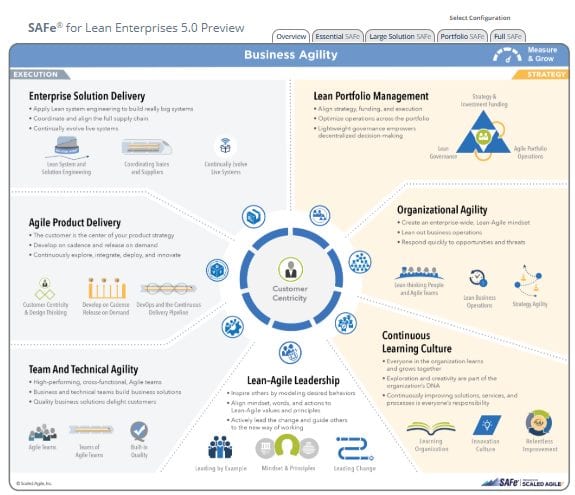Our website is not supported on this browser
The browser you are using (Internet Explorer) cannot display our content.
Please come back on a more recent browser to have the best experience possible

As we enter a new decade, the field of Project and Portfolio Management (PPM) is evolving just as quickly as the organizations that use it are. New trends are emerging that influence how practitioners go about their business of managing their portfolios day-to-day. As leaders in the field, we asked our global team to share their insights on trends in project portfolio management, and how it’s changing for the 2020’s.
No surprise here. Agile is, of course, still the number one trend to influence project and portfolio management in 2020. It is going nowhere. Quite the opposite, actually – it has risen to be the most popular project management approach today.
“At my current assignment, the company is undergoing business transformation where most, if not all, internal organizations are moving into an Agile business model,” said Lilia Cooper, a Senior Project Management Consultant for MIGSO-PCUBED (MP) in Houston, Texas. “This means that current roles could be modified if they’re not relevant in Agile, and it is certainly being met with varying levels of resistance.”
Along with its rise in usage within organizations, so too came the need to adapt interfacing organizational practices. One of the largest issues faced by organizations today is how to integrate both agile and traditional projects, and then roll them up into one single view of the portfolio.
In conversations with our Portfolio Management Community of Practice members, the most consistent trend raised was the topic of Lean Portfolio Management. Lean Portfolio Management, as the name suggests, is the management of a portfolio of projects by applying the concepts of lean thinking. In lean, the focus is on reducing waste and improving efficiency in order to deliver the most value to the end customer.
Since its initial release of the Scaled Agile Framework (SAFe) in 2011, Scaled Agile has been working to provide organizations with the tools and methods to increase productivity, drive improvements in quality, achieve faster time to market, and increase employee engagement. In its January 2020 release, SAFe for Lean Enterprises 5.0 focuses more attention on the core competencies required for achieving Business Agility, namely Lean Portfolio Management. As highlighted in the SAFe Big Picture below, the seven focus areas include in addition to Lean Portfolio Management, Organizational Agility, a Continuous Learning Culture, Lean-Agile Leadership, Team and Technical Agility, Agile Product Delivery, and Enterprise Solution Delivery.

SAFe 5.0 has significantly improved at the Portfolio level with more examples surrounding strategic themes, value streams, more experience in the Portfolio Kanban and Portfolio Canvas, and the introduction of the Lean Agile Center of Excellence. Unclear about SAFe 5.0? Read all about the new SAFe 5.0 features from our partner trip to the Scaled Agile Summit in October.
The single most significant metric in Portfolio Management has always been around measuring return on investment. Over the past few years, though, there’s been a shift from Projects to Products, and then from Products to Services. With organizations rethinking how to deliver the most value to the customer (i.e. Lean Portfolio Management above), they also need to think about how to measure that value.
Back at the 2017 Gartner Project and Portfolio Management conference, Matthew Hotle predicted that, “by 2020, digital business leaders will have pivoted from project to product portfolio management.” He recommended a focus on transforming the organization from “Projects” to “Products”, as projects are always late, while products are released continuously.
“In a nutshell, there seems to be an increased awareness on shifting from funding “Projects” to funding “Value Streams’,” said Kamlesh Thakur, Senior Consultant at MP in Houston. “Some are doing it deliberately, like start-ups and SMEs, and some are winging it.”
As this unfolds, MP’s teams are working alongside their clients to restructure how they measure and account for benefits derived from their portfolio of initiatives.
“The challenge in many organizations is how to move towards an adaptive portfolio management model that’s focused on value delivery, and optimizing traditional and agile approaches to actually delivering that value,” said Eric Foss, Vice President of Consulting Services at MP. “We need to understand how to operationalize Portfolio Management fundamentals in this adaptive environment.”
Demand management is the framework or process for managing all new projects, initiatives, products, and services within an organization. However, it’s often confused with demand vs. capacity management. In this situation, you’re figuring out how to prioritize the demand for resources in your organization versus the actual capacity you have to deliver those needs. Unfortunately, when we talk about trends in Portfolio Management, we mean both demand management and demand vs. capacity management. You can’t have one without the other. Well, you could (a lot of organizations do), but that is in fact the problem.
Because we're in such a dynamic environment, it's very important for organizations to align their spending or their investments in their future with the goals of the organization.
Sean O'Brien, MP Vice President of PPM Management
Over the past few years, organizations have seen success by implementing concepts like “innovation hubs” to unlock the agility they required in order to compete in today’s market. Agile has influenced the rise of self-forming teams, whereby what the team works on is influenced by the team and can change according to market conditions. The agility raised through innovation hubs and self-forming teams has improved both time-to-market and the ability to align with customer demand. However, it has made seeing what the organization is actively working on at any given time, or in one single place, a living nightmare.
Thankfully, we have also seen significant improvements in business analytics and collaboration tools. Tools like Microsoft Azure DevOps, Atlassian JIRA, and Trello have changed the way that project managers plan, assign, and show what work has been completed. In addition, business analytics tools like Power BI and Tableau have streamlined dashboard development for Project Managers.
We also talk about data visualization in our recent article what it takes to be a successful Project Portfolio Manager. Check-it out!
“Companies today need to be able to see the overall impact of all the projects on the company,” said Vincent Barbateau, Team Leader at MP in Nantes, France. “With the help of Business Analytics tools, we can provide interactive visualizations, create dashboards, and improve our analytics capabilities at the portfolio level.”

While many are still figuring out how to use these tools, the next step is on rolling this data up at a high level.
“One of the challenges for teams is to know how to configure the Portfolio,” said Marie Le Fresne, an MP consultant working in Detroit, MI. “What information from JIRA to use, how to set up the releases, what if you are not using sprints, how to forecast and so on.”
Enter the Digital Lab. One of the recent trends at MIGSO-PCUBED is supporting our clients in Aerospace and Automotive with Digital Dashboards. We partner with our clients to understand the portfolio of projects to be included on the dashboard and what insights they are looking to gain. Then, we work with the individual teams to both identify and cleanse the data sources to make sure their dashboards are accurate. Finally, once we have established the proof of concept, we work to integrate and automate data collection into the dashboard.
The result is an automated dashboard, significantly reducing the overhead of manual reporting. The management team has the data at their fingertips to make decisions in real-time.
Over the long term, MP practitioners are using project portfolio management tools to get a better sense of the big picture.
This article was written by Eric Shalayko
Loved what you just read?
Let's stay in touch.
No spam, only great things to read in our newsletter.
We combine our expertise with a fine knowledge of the industry to deliver high-value project management services.
MIGSO-PCUBED is part of the ALTEN group.
Find us around the world
Australia – Canada – France – Germany – Italy – Mexico – The Netherlands – Portugal – Romania – South East Asia – Spain – Switzerland – United Kingdom – United States
© 2024 MIGSO-PCUBED. All rights reserved | Legal information | Privacy Policy | Cookie Settings | Intranet
Perfect jobs also result from great environments : the team, its culture and energy.
So tell us more about you : who you are, your project, your ambitions,
and let’s find your next step together.
Dear candidates, please note that you will only be contacted via email from the following domain: migso-pcubed.com. Please remain vigilant and ensure that you interact exclusively with our official websites. The MIGSO-PCUBED Team
Choose your language
Our website is not supported on this browser
The browser you are using (Internet Explorer) cannot display our content.
Please come back on a more recent browser to have the best experience possible
